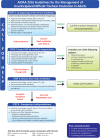All India Difficult Airway Association 2016 guidelines for the management of unanticipated difficult tracheal intubation in adults
- PMID: 28003690
- PMCID: PMC5168891
- DOI: 10.4103/0019-5049.195481
All India Difficult Airway Association 2016 guidelines for the management of unanticipated difficult tracheal intubation in adults
Abstract
The All India Difficult Airway Association (AIDAA) guidelines for management of the unanticipated difficult airway in adults provide a structured, stepwise approach to manage unanticipated difficulty during tracheal intubation in adults. They have been developed based on the available evidence; wherever robust evidence was lacking, or to suit the needs and situation in India, recommendations were arrived at by consensus opinion of airway experts, incorporating the responses to a questionnaire sent to members of the AIDAA and the Indian Society of Anaesthesiologists. We recommend optimum pre-oxygenation and nasal insufflation of 15 L/min oxygen during apnoea in all patients, and calling for help if the initial attempt at intubation is unsuccessful. Transnasal humidified rapid insufflations of oxygen at 70 L/min (transnasal humidified rapid insufflation ventilatory exchange) should be used when available. We recommend no more than three attempts at tracheal intubation and two attempts at supraglottic airway device (SAD) insertion if intubation fails, provided oxygen saturation remains ≥ 95%. Intubation should be confirmed by capnography. Blind tracheal intubation through the SAD is not recommended. If SAD insertion fails, one final attempt at mask ventilation should be tried after ensuring neuromuscular blockade using the optimal technique for mask ventilation. Failure to intubate the trachea as well as an inability to ventilate the lungs by face mask and SAD constitutes 'complete ventilation failure', and emergency cricothyroidotomy should be performed. Patient counselling, documentation and standard reporting of the airway difficulty using a 'difficult airway alert form' must be done. In addition, the AIDAA provides suggestions for the contents of a difficult airway cart.
Keywords: Complete ventilation failure; emergency cricothyroidotomy; pre-oxygenation; supraglottic airway devices; unanticipated difficult intubation.
Conflict of interest statement
There are no conflicts of interest.
Figures



References
-
- Apfelbaum JL, Hagberg CA, Caplan RA, Blitt CD, Connis RT, Nickinovich DG, et al. Practice guidelines for management of the difficult airway: An updated report by the American Society of Anesthesiologists task force on management of the difficult airway. Anesthesiology. 2013;118:251–70. - PubMed
-
- Petrini F, Accorsi A, Adrario E, Agrò F, Amicucci G, Antonelli M, et al. Recommendations for airway control and difficult airway management. Minerva Anestesiol. 2005;71:617–57. - PubMed
LinkOut - more resources
Full Text Sources
Other Literature Sources

